
|
|

December 3, 2010
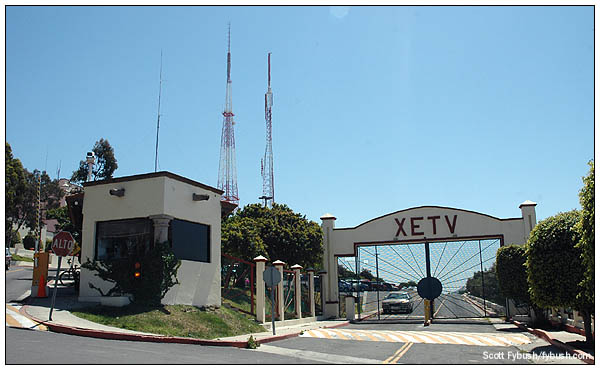 XETV, Tijuana/San Diego
XETV, Tijuana/San Diego
Originally published February 13, 2009
One of the truly fun parts of doing "Tower Site of the Week" is the unusual invitations it brings our way. Our April 2008 pre-NAB swing through southern California was particularly remarkable in that respect - it brought us everywhere from the World's Shortest Blaw-Knox Diamond Tower to the last remaining rooftop "hammock" AM antenna to the unique operation we're showing you this week: the cross-border TV legend that is XETV, channel 6, licensed to Tijuana, Baja California, Mexico and serving all of sunny San Diego.
(It's also one of the featured pages in Tower Site Calendar 2010, which is why we're bringing it to you as an encore presentation this week...)
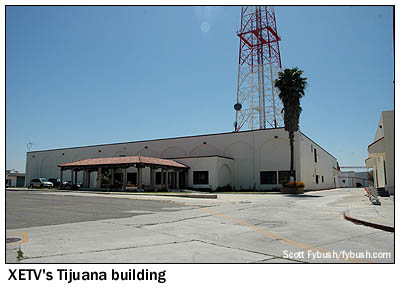
|
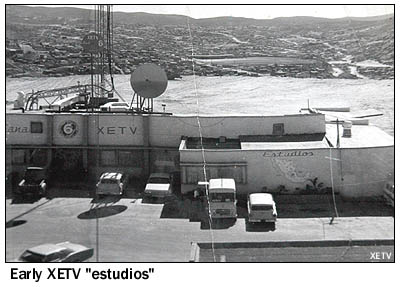
|
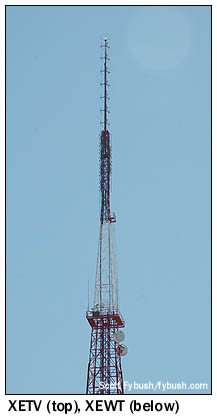 "History,"
you say? But of course...
"History,"
you say? But of course...
XETV arrived on the broadcast scene in January 1953, providing a third VHF signal to the San Diego area to accompany KFMB-TV (Channel 8) and KOGO-TV (Channel 10) on the U.S. side of the border.
As with so much of the Mexican broadcast landscape, the station was owned by the Azcarraga family of Mexico City. They controlled the capital's XEW radio and TV, and would soon take their Spanish-language programming nationwide under the "Telesistema Mexicana" banner, antecedent of today's media giant Televisa.
But in Tijuana, there was more money to be made programming for a cross-border, English-speaking audience than there was in aiming at the locals, so it would be seven more years before a Spanish-language sister station would arrive on the scene as a counterpart to English-language XETV. (That sister station, XEWT, will be the subject of next week's installment of "Site of the Week," and you're in for a treat when you see what its facility, across the parking lot from XETV, looks like!)
From the beginning, XETV operated from a tower and studio/office building atop Mount San Antonio, one of the highest hilltops in Tijuana, with a commanding line-of-sight view north to the border a few miles away, and to much of San Diego beyond.
For much of its history, most of XETV's operation (save for some sales personnel) was up here on the Mexican side. In 1956, XETV gained a network affiliation with ABC, though network programming had to be recorded on the U.S. side and physically transported (first on film, later on tape) across the border to Mount San Antonio for transmission. Even local news was anchored from the Tijuana studios - though news went away after XETV lost its ABC affiliation to San Diego's KCST (Channel 39) in 1972, becoming an independent.
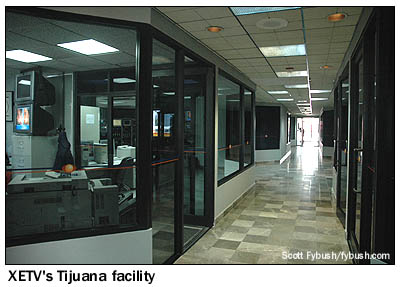
|
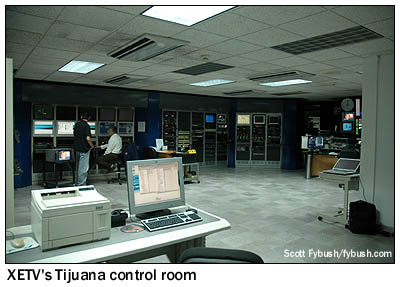
|
In 1986, XETV signed on with the upstart Fox network, becoming one of the first Fox affiliates, and in time the station was able to secure a waiver allowing it to feed live programming across the border from the U.S.
By the time we visited in April 2008, XETV's broadcast day was fully programmed from the U.S. side of the border (we'll see that operation shortly), under an unusual arrangement that effectively split XETV into two halves: in San Diego, a Televisa-owned subsidiary called Bay City Television operates a newsroom, sales office and studio for the station, while up on Mount San Antonio, Televisa itself operates the transmitters and the master control point that merges network programming (received directly by satellite from the U.S.) with the local content (news and spots) being fed from the San Diego control room via a cross-border microwave link.
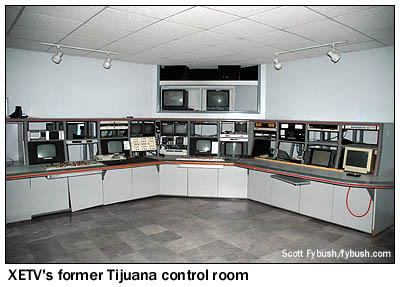
|
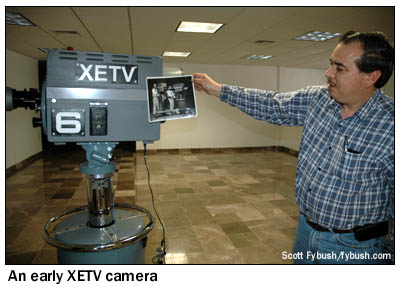
|
When we arrived on Mount San Antonio in the company of XETV's U.S.-based chief engineer Gary Stigall and operations director Bob Anderson, the station was in the midst of a big transition - it had just received word that it would soon lose that Fox affiliation to Tribune's San Diego-based KSWB (Channel 69). That change happened on August 1, 2008, when KSWB became "Fox 5" (cable penetration in San Diego is about as high as it gets anywhere) and XETV ended up with CW as "San Diego 6."
But that was all in the future when we visited, and now we can share with you what's become a bit of a time capsule of a station near the end of a most interesting era.
From the looks of it, XETV's current building on Mount San Antonio appears to date from the late eighties or early nineties, and it's both very large and rather empty, since so much of the station's operation is now across the border. The road up to the XETV building winds past the guard booth that separates Televisa's hilltop from the dense welter of houses leading up the hill from the city below, then passes the immense XEWT building before arriving at a big parking lot in front of the two tall towers here, one for XETV and XEWT's analog signals, the other - as we'll see next week - for the many DTV signals now up here.
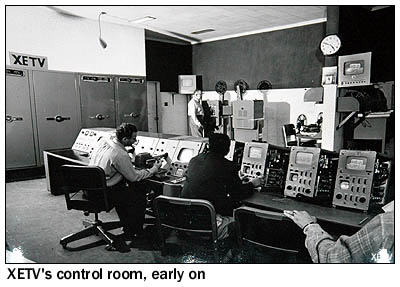
|
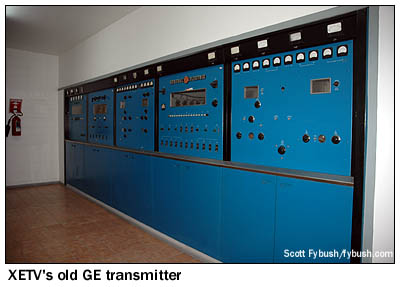
|
I think - but am not certain - that much of the parking lot sits where the original XETV building (seen in the black-and-white photo at the top of the page) once sat, and that the current XETV building sits where the original XETV tower once was. In any event, that old building is long gone, and with it the original transmitter (a Federal, I think) seen alongside the film chains and control-room gear in that nifty vintage photo above at left, part of a sheaf of old photos and documentation maintained with pride by the Mexican engineering staff here.
And "pride" is definitely the operative word - these are among the cleanest, best-maintained facilities we've ever had the pleasure of touring. An original DuMont camera from XETV's early days is displayed on a pedestal near the entrance to the mostly-vacant office side of the XETV building, and that's a photo of that same camera in use at the old studios being displayed by one of the Mexican engineers.
Over on the operations side of the building, we counted at least four engineers on duty in the big control room on one side of the shiny tile hallway, monitoring the master control, the Fox downlink, and the downlink from the San Diego studios. Across the hall sits the former master control that was used before most local origination moved to San Diego, vacant for the moment, but perhaps not for long.
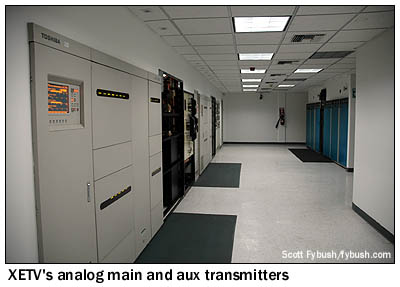
|
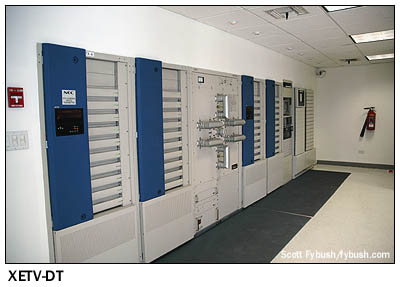
|
The transmitters for channel 6 analog sit at the back of the building, and there's history here as well: a vintage GE transmitter (which still runs!) has been lovingly repainted in what looks like Harris blue, and it's merely a tertiary auxiliary - the primary aux is an actual Harris, which sits across from XETV's main analog transmitters, a pair of Toshibas.
XETV-DT, on channel 23, was the first digital signal on the air in Mexico when it signed on in 2000, and its NEC transmitter sits in the next building over from the main XETV building. It shares the room with two other DTV transmitters: one for XEWT-DT (32) and one for XHUAA-DT (22), which relays Mexico City's XEW-TV. All three DTVs, along with XHUAA's analog signal on channel 57, feed antennas on the newer tower, seen at right in the photo at the top of the page.
We saw the rest of XEWT and XHUAA in another 2009 installment, but for now we'll share some pictures of XETV's San Diego operation, on Ronson Road in the Kearny Mesa neighborhood north of downtown San Diego.
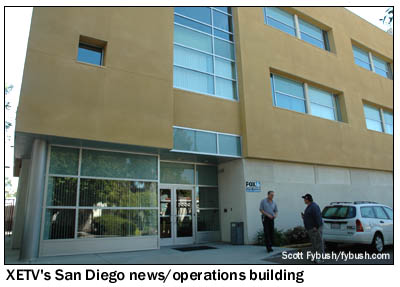
|

|
When XETV added a local news operation in 2000, it couldn't fit into its existing one-story building on Ronson Road, so it left sales and management in the old building and constructed a three-story, 25,000-square foot operations building next door. It's laid out fairly simply: a long corridor on the first floor leads past a green room on one side and control rooms on the other, then back into the studio, where the four-hour morning show is wrapping up when we stop by.
The newsroom is upstairs, taking up most of the second floor, with a big window looking down into the studio, while the third floor is home to promotions, production and engineering offices. (And that's Gary Stigall out front, chatting with SDRadio.net proprietor Chris Carmichael, our driver for the excursion into Mexico, where our rental car couldn't go.)

|

|
The strong local news presence XETV built up in the last few years served it well when it transitioned to "San Diego's 6" and CW a few months after our visit. And the huge cable/satellite penetration in the market means that XETV won't be much affected by the transition away from analog TV on the U.S. side of the border.
(An interesting note here: neither the direct cable feed nor XETV-DT carry the Mexican presidential addresses that are apparently mandatory carriage only for broadcast analog TV; the occasional interruption of programming such as Fox football thus produced calls of complaint only from the handful of over-the-air analog viewers - and from subscribers to a handful of small cable systems in remote areas north and east of San Diego that were taking analog 6 over the air.)
(UPDATE: At the time this feature first ran, just before the originally-scheduled February 2009 US analog TV shutdown, XETV planned to flip its analog channel 6 signal to Spanish-language programming, continuing in English on XETV-DT and the cable feed to US viewers; that plan was delayed indefinitely, and XETV continues to operate in English on both analog 6 and digital 23.)
 - Find out when the new Tower Site is posted,
and much more! Follow us on Twitter @NERadioWatch - and don't miss your chance to order the all-new
Tower Site Calendar 2011, complete with XETV, at the Fybush.com store!
- Find out when the new Tower Site is posted,
and much more! Follow us on Twitter @NERadioWatch - and don't miss your chance to order the all-new
Tower Site Calendar 2011, complete with XETV, at the Fybush.com store!- Previous Site of the Week: KEVA, Evanston, WY
- Next Week: WCAP, Lowell, MA
- Site of the Week INDEX!
- How can you help support Site of the Week? Click here!
- Submit your suggestions for a future Site of the Week!

